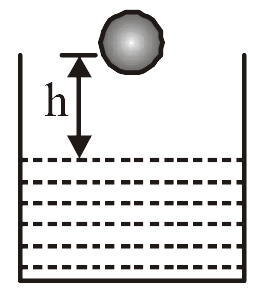A metal ball ofradius 10−4 m and density 104kg/m3 falls freely under gravity through a distance 'h' and enters a tank of water. It is found that after entering the water, the velocity of ball does not change. What is the value of h?
[ηfor water 10−5 Pas ,g=10m/s2 and orhwater=103kg/m3]
10m
15m
18m
20m
The correct Answer is:D
When the ball falls through a vertical height h, it acquires the velocity v=√2gh [v2=u2+2gh]
and since this velocity does not change, when the ball travels through water, it must be its terminal velocity or critical velocity(vc)=√2gh
It is given by vc=29r2(ρ−σ)gη
∴ √2gh=2r29(ρ−σ)gη
∴ h=[2r29(ρ−σ)gη]2×12g
=⎡⎣2×(10−4)2×(10+4−10+3)×109×10−5⎤⎦2×120
=[2×10−8×9×103×101×1059]2×120
∴ h=20×2020=20m
Topper's Solved these Questions
- FRICTIONAL IN SOLIDS AND LIQUIDS BOOK - MARVEL PUBLICATIONCHAPTER - FRICTIONAL IN SOLIDS AND LIQUIDS EXERCISE - TEST YOUR GRASP
10 Videos
- FORCE, WORK AND TORQUEBOOK - MARVEL PUBLICATIONCHAPTER - FORCE, WORK AND TORQUEEXERCISE - TEST YOUR GRASP
10 Videos
- MAGNETIC EFFECT OF ELECTRIC CURRENT BOOK - MARVEL PUBLICATIONCHAPTER - MAGNETIC EFFECT OF ELECTRIC CURRENT EXERCISE - TEST YOUR GRASP
10 Videos
Similar Questions
A spherical ball of radius 3.0×10−4m and density 104kg/m3 falls freely under gravity through a distance h before entering a tank of water. If after entering the water the velocity of the ball does not change, find h. Viscosity of water is 9.8×106N−s/m2.
View SolutionA spherical ball of radius 3×10−4m and density 104kg/m3 falls freely under gravity through a distance h before entering a tank of water. If after entering the water the velocity of the ball does not change, find h the viscosity of water is 9.8×10−6N−s/m2
View Solution
Knowledge Check
Velocity of flow of water in a horizontal pipe is 10.0 m/s. Find the velocity head of water (g=10m/s2)
A9.00mB5.00 mC3.00 mDNone of theseA solid ball of density half that of water falls freely under gravity from a height of 19.6 m and then enters water. Neglecting air resistance and viscosity effect in water, the depth up to which the ball will go is (g=9.8m/s2)
A19.6 mB9.8 mC14.7 mD12.7 m
A small ball of radius 'r' falls freely under gravity through a distance 'h' before entering a tank of water. If after entering the water, the velocity of ball does not change, the 'h' is proportional to
View SolutionA small ball of radius 'r' falls freely under gravity through a distance 'h' before entering a tank of water. If after entering the water, the velocity of ball does not change, the 'h' is proportional to
View SolutionA spherical ball of radius 3.0×10−4 m and density 104kgm3 falls freely under gravity through a distance H=n×500m before entering a tank of water. If after enerting the water the velocity of the ball does not change, then find n. viscosity of water is 10×10−6N−sm2,g=10ms
View SolutionA ball of radius r and density r falls freely under gravity through a distance h before entering water. Velocity of ball does not change even on entering water. If viscosity of water is η the value of h is given by

View SolutionA metallic sphere of radius 1.0×10−3m and density 1.0×104kg/m3 enters a tank of water, after a free fall through a distance of h in the earth's gravitational field. If its velocity remains unchanged after entering water, determine the value of h. Given: coefficient of viscosity of water =1.0×10−3Ns/m2,g=10ms−12 and density of water =1.0×103kg/m3.
View SolutionConsider a ball of density 0.5×103kg/m3 falling freely into the water from a height of 10 cm. Now, find the depth (in centimetres) to which the ball will sink:
View Solution
